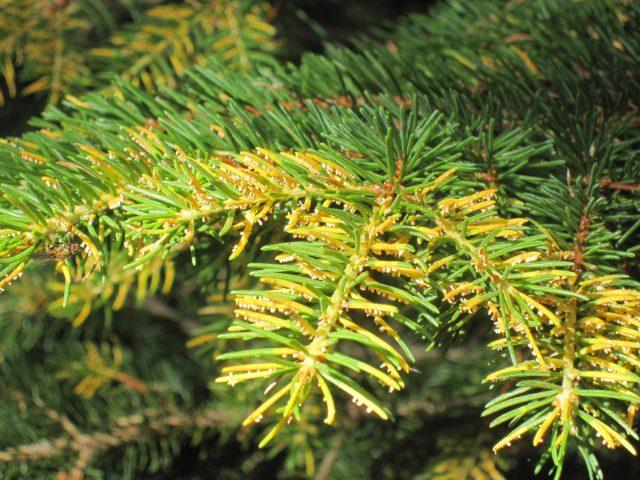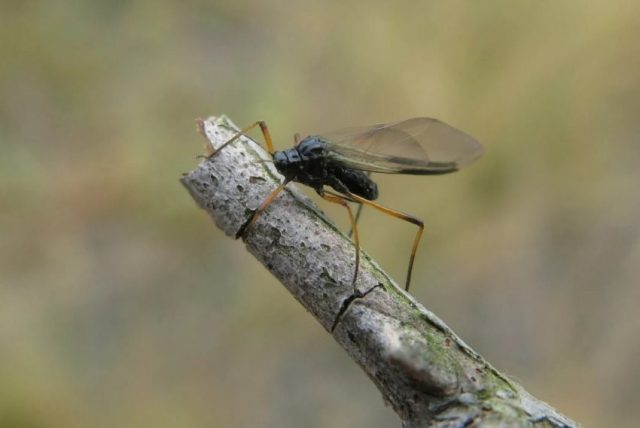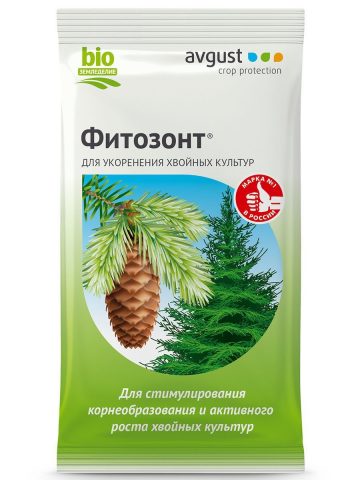Content
Despite its ease of care and general endurance, spruce also reacts to the negative impact of external natural factors and gardener mistakes in care. A set of symptoms signals a deterioration in health. One of the most common is the yellowness of the needles, due to which the tree greatly loses its decorative properties. Understanding exactly why the blue spruce turned yellow is extremely important: without knowing the reasons, it is impossible to take effective measures to restore its healthy appearance.
Signs of yellowing
The natural shade of spruce needles is dark emerald. In hybrids bred by breeders, it can be grey-gray, blue-white, light or grassy green or golden yellow. In the latter case, you can understand that it is turning yellow only when the needles acquire a brick-rusty hue.
In other varieties, the needles first gradually fade, then turn yellow, rust and crumble. As a rule, negative changes first appear on the lowest branches and, if nothing is done, gradually rise up the crown.

A tree with yellowing needles in most cases stops developing
Why do spruce needles turn yellow?
It is obvious from the photo that a spruce with yellow or brown needles looks unpresentable. There can be many reasons for this, so you cannot take action without identifying the source of the negative influence. The chaotic actions of the gardener will be useless for the tree at best.
Lack of moisture
The spruce turns yellow if the weather is hot for a long time, there is no precipitation, and the gardener neglects watering. It tolerates moisture deficiency much better than waterlogged soil, but it still cannot exist constantly without water.
In addition, the needles of blue spruce and other spruce seedlings with a closed root system often turn yellow soon after transplanting into the ground. The soil in such containers may well be too dry. If the gardener does not moisten the soil in the planting hole before planting and in the tree trunk circle after it, the spruce refuses to form roots and, accordingly, take root in a new place. Its above-ground part gradually dies off, the process begins with the needles turning yellow.

Often during the season the tree gets by with natural rainfall, but in extreme heat one should not forget about watering
Late boarding
Spruce is planted in the fall, taking into account not only local climatic conditions, but also the long-term weather forecast. Over time, you need to guess so that there is about a month left before the first frost. Then she has time to form new roots and hibernate.
If a gardener is clearly late in planting a spruce tree, with the onset of cold weather its needles continue to actively evaporate moisture. The tree is no longer able to replenish the resulting deficit, which leads to dehydration.In such conditions, the spruce needles first turn yellow, turn brown and fall off en masse, then the young shoots begin to dry out and die.
Freezing
Natural forest spruces overwinter without damage or with minimal damage at temperatures down to -45 °C. However, many breeding hybrids cannot boast of such cold resistance.
As a rule, with minor lesions, a spruce that has turned yellow with the onset of winter is able to recover on its own; you just need to wait. The color of the needles returns to normal within a month and a half. This also applies to selection hybrids.
Burn
Ordinary forest spruce trees rarely get sunburned in the summer, even when there is intense heat for a long time, and they are planted where they are exposed to direct sunlight. But hybrids bred by breeders, especially those with colored needles, may well suffer. Their needles first become dull, then turn yellow, turn brown and fall off.
Spruce can get sunburn not only in summer, but also in winter. In the latter case, this probability is even higher - when the rays are reflected from the snow, the intensity of their impact increases.

Severe cold and strong winds aggravate the damage caused by winter sunburn.
Lack of nutrition
Spruce needles can turn yellow due to a general nutritional deficiency, when, due to a lack of basic macroelements, the tree gets rid of green mass, starting from the youngest shoots.But, if the gardener still does not neglect feeding, the needles most likely turn yellow due to a lack of magnesium.
The process goes from the bottom up, the first signs appear on the lowest and oldest branches. The needles on spruce trees turn yellow, first in spots, then completely. Often they curl, the surface becomes wrinkled.
Seasonal change of needles
The lifespan of each needle is 3-7 years. The spruce tree changes them in the fall, getting rid of about 1/7 of the needles annually. In the northern regions, leaf fall begins in the second ten days of September, in the south - towards the end of October. That is, when some of the needles on spruce trees turn yellow and fall off in the fall, this is a natural process that the gardener cannot influence in any way.

The spruce sheds most of its needles from the oldest lower branches
The tree is under stress
Spruce is a very hardy tree. However, even her needles sometimes turn yellow under the influence of constant stress. The most common reason is a sharp spring warming after severe frosts, when the above-ground part begins to develop, but the roots are still dormant. As a result, a deficiency of water and nutrients occurs, the needles turn yellow and fall off.
A situation where a gardener regularly pours soapy water under a tree after doing laundry or washing dishes becomes a constant stress. Also, the needles turn yellow if dogs and cats living on the site choose its near-trunk circle as a toilet.
Stress for spruce will also be transfer to a region with climatic conditions radically different from those familiar to it. Therefore, if a tree is not dug up in the forest, but purchased from a nursery, you need to make sure that it is located nearby and the seedlings are grown here.
Pests
Pest attacks on spruce are rare. For most insects, its needles and wood are inedible due to the high concentration of essential oils. But there are exceptions:
- Sitka spruce aphid. Small black beetles with brown legs that settle on spruce in colonies. They feed on the sap of the plant, gradually not only the needles (starting from the tips of the branches), but also the trunk of the spruce turn yellow.
Like ordinary aphids, spruce aphids live in close symbiosis with ants
- Hermes. A close relative of the spruce aphid, it is yellow or green in color. Its attack is evidenced by yellowing and deforming needles, small whitish sticky lumps between the needles.
If nothing is done, Hermes begins to form galls on the tips of the shoots
- Printer. A small dark brown bark beetle. Gnawing out the bark, it leaves multiple holes and patterns from which beige-brown powder spills out. Blue and other spruce affected by typographers retain the natural shade of their needles for a long time, but when they turn yellow, the tree can no longer be saved.
Typographs breed especially actively when it is warm and dry outside
What to do if your spruce needles turn yellow
Often, if the needles of blue or any other spruce turn yellow, it is enough to identify your own mistakes in agricultural technology and normalize care. Then the tree quickly restores its decorative properties without additional measures.But in the case of constant stress, sunburn, pest attacks, he needs outside help to recover.
Agrotechnical measures
Like any garden crop, spruce responds gratefully to proper care. Proper agrotechnical measures will help a tree whose needles turn yellow restore its presentable appearance:
- Timely sanitary pruning. Dried, dead branches for spruce are just ballast. Pruning is carried out using sharply sharpened, disinfected tools. The resulting plant debris is burned.
- Proper watering. Spruce was especially sensitive to moisture deficiency in the first two seasons after transplantation. Here you should not allow the soil to dry out even for a short time; the needles immediately begin to turn yellow. However, overwatering is also bad for wood. Root rot develops quickly and it dies.
- Regular feeding. To prevent spruce needles from turning yellow, they are regularly fed with special fertilizers for conifers. They are applied at the beginning of the active growing season and about a month before frost. At the end of July or at the beginning of August, foliar feeding with biostimulants is carried out.
- Shelter for the winter. When deciding whether it is necessary and capital, they take into account the cold resistance of a particular variety or hybrid and the weather forecast for the winter. It is also recommended to play it safe and cover the seedlings in the first season after transplantation.

Universal spruce garden fertilizers will not work
Drugs
When spruce needles turn yellow due to damage by diseases or pests or prolonged stress, they need treatment using suitable insecticides, fungicides or biostimulants.Folk remedies in the case of coniferous trees are ineffective, even if the problem is noticed at an early stage and the gardener begins to take action in time.
What you can use:
- Angle. An effective remedy for combating the most typical diseases of conifers, which cause the needles to turn yellow - rust and schutte. It provides the desired effect even in advanced cases.
The drug Racurs has a prolonged action: it quickly sticks to the branches and stays on them for a long time
- Phytoumbrella Coniferous. It is used when planting seedlings and replanting spruce to a new place, as well as for foliar feeding at the beginning of the season (April-June). The drug is useful not only for trees whose needles turn yellow, it strengthens their immunity, activates the growth of the root system and the development of the aerial parts.
Phytoumbrella Coniferous can be used to treat spruce trees whose needles have previously turned yellow
- Pinocid. A broad-spectrum insecticide used if the needles on a spruce tree turn yellow due to several types of pests at once or it is not possible to accurately identify the insect. The drug begins to act within an hour after treatment; adults die within the next 24 hours.
The effectiveness of the drug Pinocid is ensured by the presence of three active ingredients
- Vallar. A preparation for protecting the roots of spruce seedlings from soil-dwelling pests that can gnaw their roots. The above-ground part of such plants does not receive sufficient nutrition, the needles gradually turn yellow, and the shoots die.
Vallar are long-acting granules; they are added to the soil no more than once per season.
Preventive measures
The best prevention for gardeners who do not want to see a spruce with unnaturally yellow or brown needles on their property is proper care.You don’t have to spend a lot of time and effort on the tree. In fact, agricultural technology is limited to infrequent watering, fertilizing, and sanitary pruning. The formation of the crown is carried out at will, the issue of shelter for the winter is decided individually.
It is equally important to know and take into account all the nuances of the procedure when planting and replanting a tree. Be sure to pay attention to the requirements of a particular variety or hybrid for the place of growth, the quality of the substrate, neighbors, and so on.

The requirements for the planting site for natural spruce trees and hybrids bred by breeders largely coincide
Conclusion
If your blue spruce has turned yellow, you can almost certainly say that negative external influences are to blame. Natural causes also cannot be excluded, but, nevertheless, the tree suffers much more often from the vagaries of the weather and the gardener’s mistakes in agricultural technology. It is necessary to understand why the spruce turns yellow as quickly as possible. The effectiveness of the measures taken by gardeners to restore its decorative properties directly depends on how correctly the cause of the deterioration of its appearance is established.















